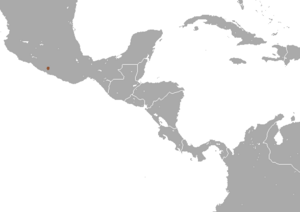Omilteme cottontail facts for kids
Quick facts for kids Omilteme cottontail |
|
|---|---|
| Conservation status | |
| Scientific classification | |
| Genus: |
Sylvilagus
|
| Species: |
insonus
|
 |
|
| Omilteme cottontail range | |
The Omilteme cottontail (Sylvilagus insonus) is a special type of cottontail rabbit. It lives only in the Sierra Madre del Sur mountains in Guerrero, Mexico. This rabbit is part of the Leporidae family, which includes all rabbits and hares. It's one of 14 species in the Sylvilagus group, found only in the Americas. The Omilteme cottontail is very rare. It is known from only a few animals ever found. This makes it one of the most endangered rabbit species in the world.
Contents
What the Omilteme Cottontail Looks Like
The Omilteme cottontail is a large rabbit. It has long ears, usually more than 53 millimeters (about 2 inches) from their base. Its back feet are medium-sized, longer than 81 millimeters (about 3.2 inches). It also has a short tail.
This rabbit has a very unique fur color. Around its nose and eyes, the fur is a dull gray. The outside of its ears is dark brown-black. This dark color is strongest along the front edge and tips of the ears.
Its back is a reddish-brown color mixed with black. Its sides are gray-black. The top of its medium-sized back feet are white. The bottoms of its feet are dark brown. The top of its tail is reddish-black, and the underside is white.
Omilteme Cottontail Anatomy
Scientists have studied the Omilteme cottontail's skull a lot. The skull is large, about 78 millimeters (about 3 inches) long. It is about 32 millimeters (about 1.2 inches) deep. It has a wide roof of the mouth and a large braincase.
The skull has a flat bone above the eye called the supraorbital process. This bone is connected to the braincase. It has two parts that stick out, one in front and one in back. The front part is attached to the skull. The back part is thin and can be separate or slightly attached to the braincase.
The Omilteme cottontail has 28 teeth in total. Like other rabbits, they have incisors (for cutting), premolars, and molars (for grinding). They do not have canine teeth.
How it Differs from Other Rabbits
The Omilteme cottontail is different from some other rabbits in its group. For example, it has a larger skull than the forest rabbit and Dice's cottontail. It also has a wider cheekbone and a deeper snout. Its tail is two colors (reddish and black), while some other rabbits have a single-colored tail. Its back feet are white and brown, not just brown. Its ears are also longer.
Compared to the Mexican cottontail, which lives in the same area, the Omilteme cottontail is smaller. It has shorter upper incisors and a shorter skull. Its fur color is also different. The Omilteme cottontail is reddish-black on its back, while the Mexican cottontail is only gray.
Where the Omilteme Cottontail Lives
The Omilteme cottontail lives only in Mexico. It is found in the Sierra Madre del Sur mountains in the state of Guerrero. It is known from a specific place called Omiltemi Ecological State Park. This park is on a wooded mountaintop in a somewhat isolated mountain range.
These rabbits live at high elevations, from about 2,133 to 3,048 meters (7,000 to 10,000 feet) above sea level. The village of Omiltemi is nearby, at 2,332 meters (7,650 feet). This means the Omilteme cottontail lives in a very small area, less than 500 square kilometers (about 193 square miles).
Omilteme Cottontail Habitat and Habits
The Omilteme cottontail lives at the top of a mountain range. This area has steep slopes and deep valleys. These places are covered with thick cloud forests. There are also some pine and pine-oak forests.
This rabbit shares its home with 37 other types of mammals. In the dense cloud forests, the rabbit lives among the plants close to the ground. It makes paths and burrows (tunnels) under things like rocks. The Omilteme cottontail is mostly active at night.
Status and Conservation
The IUCN Red List of Threatened Species says the Omilteme cottontail is "data deficient." This means scientists don't have enough information to know exactly how endangered it is.
The biggest dangers to this rabbit are illegal hunting and losing its home. Its habitat is being destroyed by deforestation, which is when forests are cut down.
For many years, from the early 1900s to the 1990s, no one saw this rabbit in the wild. But in 1998, two rabbits were found. This confirmed that the species was still alive! The Omilteme cottontail is one of 25 "most wanted lost" species. These are animals that Global Wildlife Conservation is actively searching for.
Images for kids
See also
 In Spanish: Conejo de Omiltemi para niños
In Spanish: Conejo de Omiltemi para niños



